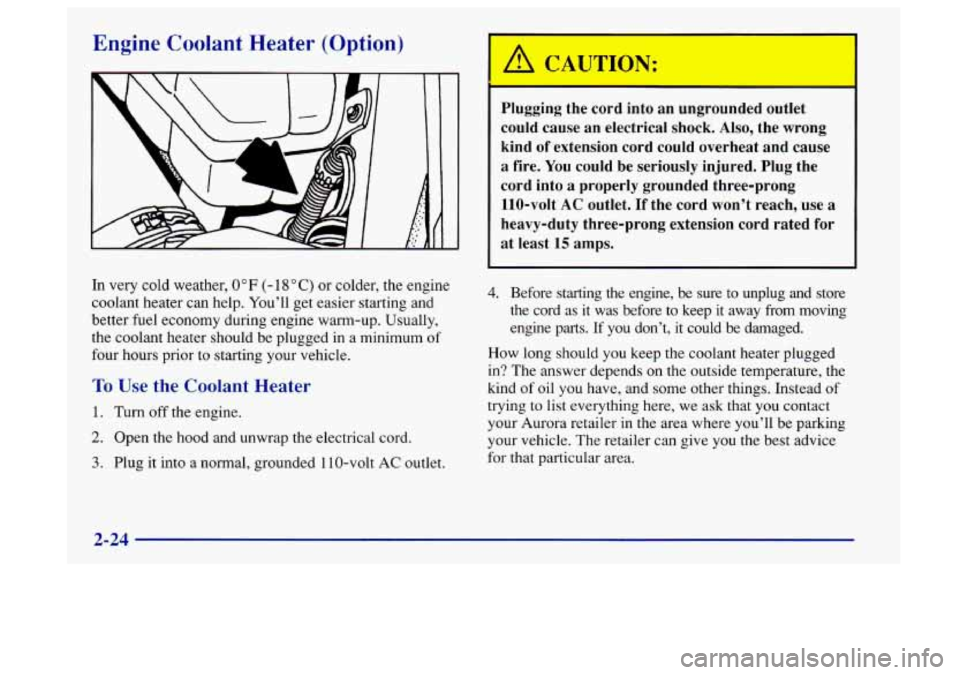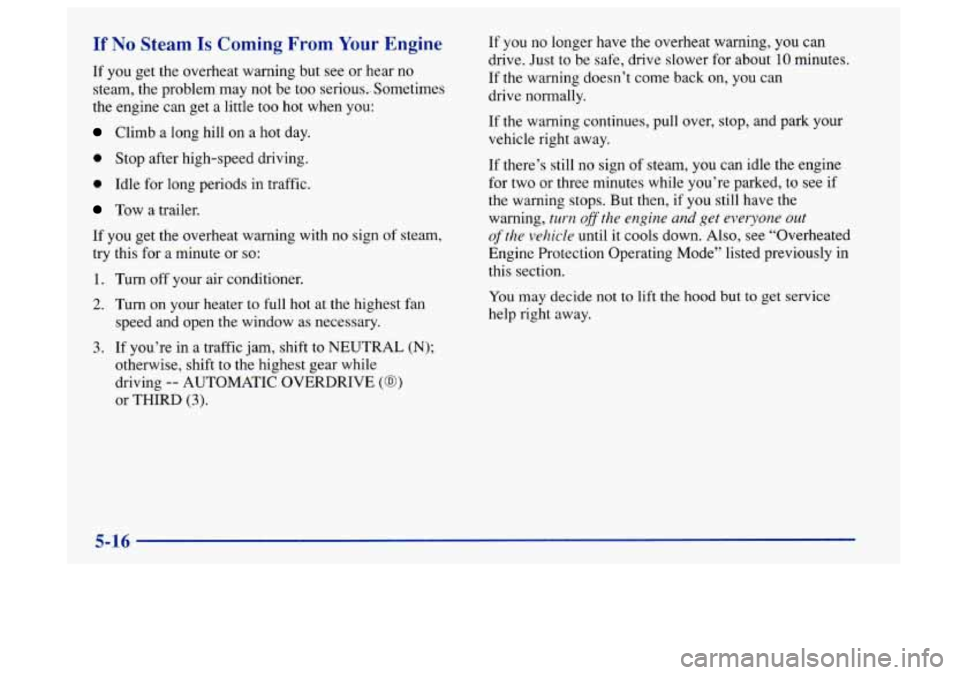1997 Oldsmobile Aurora open hood
[x] Cancel search: open hoodPage 80 of 404

Engine Coolant Heater (Option)
A r ~UTIO: :
I- -
Plugging the cord into an ungrounded outlet
could cause an electrical shock. Also, the wrong
kind of extension cord could overheat and cause
a fire. You could be seriously injured. Plug the
cord into
a properly grounded three-prong
110-volt
AC outlet. If the cord won’t reach, use a
heavy-duty three-prong extension cord rated for
at least 15 amps.
In very cold weather,
0 “F (- 18 O C) or colder, the engine
coolant heater can help. You’ll get easier starting and
better fuel economy during engine warm-up. Usually,
the coolant heater should be plugged in a minimum
of
four hours prior to starting your vehicle.
4. Before starting the engine, be sure to unplug and store
the cord as it was before to keep
it away from moving
engine parts.
If you don’t, it could be damaged.
How long should you keep the coolant heater plugged
in? The answer depends on the outside temperature, the
kind
of oil you have, and some other things. Instead of
trying to list everything here, we ask that you contact
your Aurora retailer in the area where you’ll be parking
your vehicle. The retailer can give you the best advice
for that particular area.
To Use the Coolant Heater
1. Turn off the engine.
2. Open the hood and unwrap the electrical cord.
3. Plug it into a normal, grounded 110-volt AC outlet.
2-24
Page 220 of 404

2. Get the vehicles close enough so the jumper cables
can reach, but be sure the vehicles aren’t touching
each other.
If they are, it could cause a ground
connection you don’t want. You wouldn’t be able to
start your Aurora, and the bad grounding could
damage the electrical systems.
To avoid the possibility
of the vehicles rolling, set
the parking brake firmly on both vehicles involved in
the jump start procedure. Put an automatic transaxle
in
PARK (P) before setting the parking brake.
3. Turn off the ignition on both vehicles. Unplug
unnecessary accessories plugged into the cigarette
lighter or accessory power outlet.
Turn off all lamps
that aren’t needed as well as radios. This will avoid
sparks and help save both batteries. In addition, it
could save your radio.
NOTICE:
If you leave your radio on, it could be badly
damaged. The repairs wouldn’t be covered by
your warranty.
4. Open the hoods and locate the other vehicle’s battery
and the Aurora’s remote positive
(+) jump starting
terminal in the box on the passenger side
of the
engine compartment.
(Your Aurora’s battery isn’t
under the hood.)
An electric fan can start up even when the engine
is not running and can injure you. Keep hands,
clothing and tsols away from any underhood
electric fan.
5-4
Page 231 of 404

If Steam Is Coming From Your Engine
ontin d)
I
Steam from an overheated engine can burn you
badly, even if you just open the hood. Stay away
from the engine if you see or hear steam coming
CAUTION: (Continued) from
it. Just turn
it off and get everyone away
from the vehicle until it cools down. Wait until
there is no sign
of steam or coolant before you
open the hood.
If you keep driving when your engine is
overheated, the liquids in it can catch fire.
You or
others could be badly burned. Stop your engine if
it overheats, and get out of the vehicle until the
engine is cool.
I NOTICE:
If your engine catches fire because you keep
driving with no coolant, your vehicle can be
badly damaged. The costly repairs would not be
covered by your warranty. See “Overheated
Engine Protection Operating Mode” in the Index.
5-15
Page 232 of 404

If No Steam Is Coming From Your Engine
If you get the overheat warning but see or hear no
steam, the problem may not be too serious..Sometimes
the engine can get a little too hot when you:
Climb a long hill on a hot day.
0 Stop after high-speed driving.
0 Idle for long periods in traffic.
Tow a trailer.
If you get the overheat warning with no sign
of steam,
try this for a minute or
so:
1. Turn off your air conditioner.
2. Turn on your heater to full hot at the highest fan
speed and open
the window as necessary.
If you no longer have the overheat warning, you can
drive. Just to be safe, drive slower for about
10 minutes.
If the warning doesn’t come back on, you can
drive normally.
If the warning continues, pull over, stop, and park your
vehicle right away.
If there’s still no sign of steam, you can idle the engine
for two or three minutes while you’re parked, to see
if
the warning stops. But then, if you still have the
warning,
turn 0fSth.e engine and get everyone out
of the vehicle until it cools down. Also, see “Overheated
Engine Protection Operating Mode” listed previously in
this section.
You may decide not to lift the hood but to eet service
help right away.
3. If you’re in a traffic jam, shift to NEUTRAL (N);
otherwise, shift to the highest gear while
driving
-- AUTOMATIC OVERDRIVE (@)
or THIRD (3).
5-16
Page 255 of 404

Adding Equipment to the Outside of Your
Vehicle
Things you might add to the outside of your vehicle can
affect the airflow around it. This may cause wind noise
and affect windshield washer performance. Check with
your Aurora retailer before adding equipment to the
outside of your vehicle.
Fuel
Use premium unleaded gasoline rated at 91 octane or
higher. At a minimum, it should meet specifications
ASTM D4814 in the United States and CGSB 3.5-M93
in Canada. Improved gasoline specifications have been
developed by the American Automobile Manufacturers
Association (AAMA) for better vehicle performance and engine protection. Gasolines meeting the AAMA
specification could provide improved driveability and
emission control system protection compared to
other gasolines.
Be sure the posted octane for premium is at least 9 1. If
the octane is less than 9
1, you may get a heavy knocking
noise when you drive. (In an emergency, you may be
able to use a lower octane
-- as low as 87 -- if heavy
knocking does not occur.)
If you’re using 91 or higher
octane unleaded gasoline and you hear heavy knocking,
your engine needs service.
If your vehicle is certified to meet California Emission
Standards (indicated on the underhood tune-up label), it
is designed to operate on fuels that meet California
specifications. If such fuels are not available in states
adopting California emissions standards, your vehicle
will operate satisfactorily on fuels meeting federal
specifications, but emission control system performance
may be affected. The malfunction indicator lamp on
your instrument panel may turn on and/or your vehicle
may fail a smog-check test.
If this occurs, return to your
authorized Aurora retailer for diagnosis to determine the
cause of failure.
In the event it is determined that the
cause of the condition is the type of fuels used, repairs
may not be covered by your warranty.
Some gasolines that are not reformulated for low
emissions contain an octane-enhancing additive called
methylcyclopentadienyl manganese tricarbonyl (MMT);
ask your service station operator whether or not his fuel
contains MMT. General Motors does not recornend the
use of such gasolines.
If fuels containing MMT are used,
spark plug life may be reduced and your emission
control system performance may be affkcted. The
malfunction indicator lamp on your instrument panel
may turn on.
If this occurs, return to your authorized
Aurora retailer for service.
6-3
Page 260 of 404

Checking Things Under the Hood
I k!, CAUTION:
An electric fan under the hood can start up and
injure you even when the engine is not running.
Keep hands, clothing and tools
away from any
underhood electric fan.
1
I
Things that burn can get on hot engine parts and start
a fire. These include liquids like gasoline,
oil, coolant, brake fluid, windshield washer and
other fluids, and plastic
or rubber. You or others
could be burned. Be careful not to drop or spill
things that will burn onto
a hot engine.
The following sections tell you how
to check fluids,
lubricants and important parts underhood. Hood Release
To open the hood,
first pull
the
hood release handle
inside the vehicle, located
to
the left of the steering wheel
under the instrument panel.
6-8
Page 262 of 404

4.0L Engine
When you open the hood, you’ll see: ~
A. Remote Positive
Battery Terminal
B. Windshield Washer
Fluid Reservoir C. Power Steering
Fluid Reservoir
D. Engine Oil
Fill Cap
E. Engine Oil Dipstick
F. Brake Fluid Reservoir
G. Automatic Transaxle Fluid
Dipstick (behind air cleaner)
H. Engine Coolant Surge Tank
I. Air Cleaner
6-10
Page 315 of 404

Maxifuse/Relay Center
It’s easy to check the fuses in this underhood relay
center. There are two locking arms on either side
of the
base of the cover. Reach down and unsnap each one by
pulling
the cover toward you, then pushing it away
while pulling up. Remove the cover.
The inside of the
cover has a chart that explains the features and controls
governed by each fuse and relay.
Fuses and Circuit Breakers
The wiring circuits in your vehicle are protected from
short circuits
by a combination of fuses and circuit
breakers. This greatly reduces the chance of damage
caused by electrical problems.
Look at the silver-colored band inside the fuse. If the
band is broken or melted, replace the fuse. Be sure
you replace a bad fuse with a new one of the correct
amp rating.
Two spare fuses are located below the fuse puller.
You’ll
also find spare fuses in the slots labeled “Spare” in the
following charts.
There are three main fuse panels: the instrument panel
fuse block and two (driver’s side and passenger’s side)
rear compartment fuse blocks.
Instrument Panel Fuse Block
This is located on the left side of the instrument panel.
To open it, push the latch to the left, then pull, and the
door will open.
You’ll find a fuse puller clipped to the inside of the
cover. Place the wide end of the fuse puller over the
plastic end
of the fuse. Squeeze the ends over the fuse
and pull
it out. To close the fuse door, press the door
closed and it will latch.